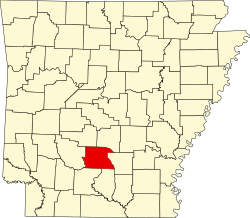Dallas County | |
|---|---|
 Courthouse in Fordyce | |
 Location within the U.S. state of Arkansas | |
 Arkansas's location within the U.S. | |
| Coordinates: 33°58′37″N92°40′23″W / 33.976944444444°N 92.673055555556°W | |
| Country | |
| State | |
| Founded | January 1, 1845 |
| Named after | George M. Dallas |
| Seat | Fordyce |
| Largest city | Fordyce |
| Area | |
• Total | 668 sq mi (1,730 km2) |
| • Land | 667 sq mi (1,730 km2) |
| • Water | 0.7 sq mi (1.8 km2) 0.1% |
| Population (2020) | |
• Total | 6,482 |
• Estimate (2024) | 6,076 |
| • Density | 9.72/sq mi (3.75/km2) |
| Time zone | UTC−6 (Central) |
| • Summer (DST) | UTC−5 (CDT) |
| Congressional district | 4th |
| Website | https://www.arcounties.org/counties/dallas/ |
Dallas County is a county located in the U.S. state of Arkansas. As of the 2020 census, the population was 6,482, [1] making it the fourth-least populous county in Arkansas. The county seat is Fordyce. [2] Dallas County is Arkansas's 49th county, formed on January 1, 1845; it was named for George M. Dallas, 11th Vice President of the United States.

